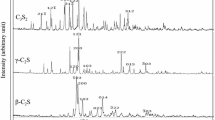Abstract
In this work, a combined method of using DSC, TG and XRD analysis in order to determine an amount of decomposed α-C2SH in its tribochemically activated mixture with quartz is presented. Furthermore, the influence of the grinding on the phase transition and heat flow during the hydration of this mixture is determined. The results showed that the product in which α-C2SH prevails is obtained after 12 h of the hydrothermal synthesis at 200 °C in stirred (50 rpm) suspensions. The purification of mentioned product using distilled water (water/solid = 500) for 5 min is enough to eliminate remaining Ca(OH)2. The stability of α-C2SH during the purification was confirmed using DSC and XRD analysis. A strong correlation between heat absorption values of the α-C2SH decomposition at 470 °C and its quantity in the mixture with quartz was noticed (R 2 = 0.9929). According to the plotted calibration curve, the amount of decomposed α-C2SH during the tribochemical activation was determined: within the first minute, it reaches 32.28 % and gradually increases to 48.73 % after 20 min. During the decomposition of α-C2SH, the semi-crystalline calcium silicate hydrates form, which recrystallize to wollastonite at 850 °C; meanwhile, the remaining α-C2SH transforms to larnite. The complex tribochemical and thermal activation of α-C2SH–quartz mixture leads to a vivid increment of its hydraulic activity: the heat flow of the main hydration reaction and the total heat values reached 3.1 mW g−1 and 104.48 J g−1, respectively.










Similar content being viewed by others
References
Peters GP, Marland G, Le Quere C, Boden T, Canadell JG, Raupach MR. Rapid growth in CO2 emissions after the 2008–2009 global financial crisis. Nat Clim Change. 2012;2:2–4.
Goni S, Guerrero A. Study of alkaline hydrothermal activation of belite cements by thermal analysis. J Therm Anal Calorim. 2010;99:471–7.
Siauciunas R, Mikaliunaite J, Urbonas L, Baltakys K. Tribochemical and thermal activation of α-C2S hydrate as a precursor for cementitious binders. J Therm Anal Calorim. 2014. doi:10.1007/s10973-014-3921-1.
Stemmermann P, Schweike U, Garbev K, Beuchle G. Celitement—a sustainable prospect for the cement industry. Cem Int. 2010;8:52–66.
Meducin F, Zanni H, Noik C, Bresson B. Tricalcium silicate (C3S) hydration under high pressure at ambient and high temperature (200 °C). Cem Concr Res. 2008;38:320–4.
Yano T, Urabe K, Ikawa H, Teraushi T, Ishizawa N, Udagawa S. Structure of α-dicalcium silicate hydrate. Acta Cryst. 1993;C47:1555–9.
Yanagisawa K, Hu X, Onda A, Kajiyoshi K. Hydration of β-dicalcium silicate at high temperatures under hydrothermal conditions. Cem Concr Res. 2006;36:810–6.
Luke K. Phase studies of pozzolanic stabilized calcium silicate hydrates at 180 °C. Cem Concr Res. 2004;34:1725–32.
Shatat MR. Effect of hydrothermal curing on the hydration characteristics of artificial pozzolanic cement pastes placed in closed system. Appl Clay Sci. 2014;96:110–5.
Yazici H, Deniz E, Baradan B. The effect of autoclave pressure, temperature and duration time on mechanical properties of reactive powder concrete. Constr Build Mater. 2013;42:53–63.
Jing Z, Fan X, Zhou L, Fan J, Zhang Y, Pan X, Ishida EH. Hydrothermal solidification behavior of municipal solid waste incineration bottom ash without any additives. Waste Manag. 2013;33:1182–9.
Palou M, Zivica V, Ifka T, Bohac M, Zmrzly M. Effect of hydrothermal curing on early hydration of G-Oil well cement. J Therm Anal Calorim. 2014;116:597–603.
Heller L. The structure of dicalcium silicate α-hydrate. Acta Cryst. 1952;5:724–8.
Midgley HG, Chopra SK. Hydrothermal reactions in the lime-rich part of the system CaO–SiO2. Mag Concr Res. 1960;34:19–26.
Imlach BV, Taylor HFW. Prolonged hydrothermal treatment of cement mixes I. Curing in water under saturated steam pressure at 140–170 °C. Trans Br Ceram Soc. 1972;71:71–5.
Hu X, Yanagisawa K, Onda Y, Kajiyoshi K. Stability and phase relations of dicalcium silicate hydrates under hydrothermal conditions. J Ceram Soc Jpn. 2006;114:174–9.
Ishida H, Yamazaki S, Sasaki K, Okada Y, Mitsuda T. α-dicalcium silicate hydrate: preparation, decomposed phase and its hydration. J Am Ceram Soc. 1993;76:1707–12.
Garbev K, Gasharova B, Beuchle G, Kreisz S, Stemmermann P. First observation of α-Ca2[SiO3(OH)](OH)–Ca6[Si2O7][SiO4](OH)2 phase transformation upon thermal treatment in air. J Am Ceram Soc. 2008;91:263–71.
Baltakys K, Dambrauskas T, Siauciunas R, Eisinas A. Formation of α-C2S hydrate in the mixtures with CaO/SiO2 = 1.75 by hydrothermal treatment at 200 °C. Romanian J Mater. 2014;44:109–15.
Siauciunas R, Rupsyte E. Formation of high basic calcium hydro silicates in mixtures with aluminium additions. Chem Technol. 2000;47:47–54 (in Lithuanian).
Colston SL, Barnes P, Jupe AC, Jacques SDM, Hall C, Livesey P, Dransfield J, Meller N, Maitland GC. An in situ synchrotron energy-dispersive diffraction study of the hydration of oilwell cement systems under high temperature/autoclave conditions up to 130 °C. Cem Concr Res. 2005;35:2223–32.
Garbev K, Beuchle G, Schweike U, Stemmermann P. Hydration behaviour of Celitement®: Kinetics, phase composition, microstructure and mechanical properties. 13th ICCC, Madrid, Spain; 2011.
Bresson B, Meducin F, Zanni HJ. Hydration of tricalcium silicate (C3S) at high temperature and high pressure. J Mater Sci. 2002;37:5355–65.
Erdogan ST. Effect of clinker phase distribution within cement particles on properties of a hydrating cement paste. Constr Build Mater. 2013;38:941–9.
Lagergren S. About the theory of so-called adsorption of soluble substances. Bihang till K. Svenska vet.-Akad Handlingar. 1898;4:1–39.
Ho YS, Wase DAJ, Forster CF. Kinetic studies of competitive heavy metal adsorption by sphagnum moss peat. Environ Technol. 1996;17:71–7.
Duchesne J, Reardon EJ. Measurement and prediction of portlandite solubility in alkali solutions. Cem Concr Res. 1995;25:1043–53.
Acknowledgements
This research was funded by a Grant (No. MIP – 077/2012) from the Research Council of Lithuania.
Author information
Authors and Affiliations
Corresponding author
Rights and permissions
About this article
Cite this article
Gendvilas, R., Siauciunas, R. & Baltakys, K. Quantitative thermal analysis of α-C2SH as a precursor for low-energy cements. J Therm Anal Calorim 121, 155–162 (2015). https://doi.org/10.1007/s10973-015-4570-8
Received:
Accepted:
Published:
Issue Date:
DOI: https://doi.org/10.1007/s10973-015-4570-8




